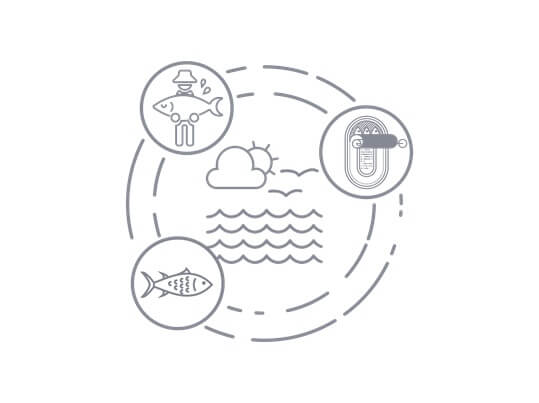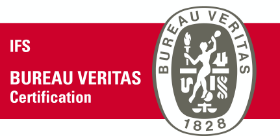The Delamaris brand has been synonymous with fish product tradition since 1879. It is a guarantee of quality, safety and excellent taste. Delamaris is focused on sustainable development, which ensures good quality of life and welfare for present and future generations. Delamaris chooses raw materials of the highest quality and is committed to sustainable fishing.
Delamaris is the only Slovenian provider of high-quality prepared fish products using completely natural raw materials. Our products, made exclusively from fish, vegetables and selected oils, are additive‑, preservative‑, gluten‑, flavour enhancer- and colouring-free, which is our distinguishing feature.
WELCOME TO PRODUCTION
RAW
MATERIALS
Top quality
STANDARDS
High quality standards
SAFETY
High safety standards
CONTROL
Above-standard control
TRACEABILITY
Throughout the production chain
COMMITMENT
Responsibility to users
DELAMARIS PRODUCTS ARE
PRESERVATIVE FREE
GMO FREE
FLAVOUR ENHANCER FREE
ALLERGEN FREE
COLOURING FREE
GLUTEN FREE
Management System Policy
Our Group is committed in the long run to the quality and safety of our products and processes, occupational health and safety, and environmental protection. This is our fundamental responsibility and employee duty.
To this end, we have established a management system based on optimising quality, safety and environmental management, and develop safe, natural, innovative, high-quality products, services and working environments to satisfy the needs of all of our stakeholders. We endeavour to offer a creative and safe working environment for our employees. We proactively encourage and support raising employee role awareness, the importance of teamwork, accountability, economy, good qualifications and motivation.


Product safety, control and standards
We meet the highest HACCP and International Food Standard (IFS) food safety standards to ensure food safety and assess quality.
HACCP
Hazard analyses and critical control points are Hazard Analysis and Critical Control Point (HACCP) managed as part of our wider quality management system.
IFS Standard

Our production complies with the internationally established IFS standards, attesting to our safety and quality compliance with the most complex and exhaustive global criteria, that is IFS Food, which is intended for companies that produce and pack food.
Responsible fishing
At Delamaris, we place great emphasis on premium quality and the traceable, controlled origin of raw materials. We work exclusively with verified and reliable suppliers. Our goal is the responsible management of marine resources and a respectful relationship with the sea and nature. We strive to source fish that are certified by the MSC (Marine Stewardship Council) and from aquaculture farms that operate responsibly and are certified by the ASC (Aquaculture Stewardship Council).
FAQ
Our hermetically-sealed cans are water, gas and microorganism resistant, and sterilised in autoclaves to protect content against deterioration, as content is virtually sterile. This is why there is no need to add preservatives. Cans are heated to temperatures above 100°C during the sterilisation process and the nutritive value of canned food is virtually the same as fresh food.
We mainly use four types of fish, namely sardines, mackerel, tuna fish and anchovy:
Mackerel (Lat. Scomber spp.), used for products that combine fish and vegetables, in fillet form or in our Tourist pâté, is a blue fish caught all over the world. It has a slender, streamlined body and deeply forked tail; its belly is silver and its body is covered in very small scales. Feeding mainly on sardines, mackerel shoals are usually found closely following large shoals of sardines and other small fish, so fishermen usually catch them together. Mackerel form large shoals close to the sea surface. Because they are caught in large quantities and become inedible quickly, they are often canned. Mackerel grow up to 45 cm long and can reach weights of up to 1 kg, but the average size fish is around 30 cm in length and between 250 and 500 g in weight, the kind used in the Delamaris’ products. It reaches sexual maturity in its third year and can live up to 20 years. The meat of this fish is tasty, dark in colour, and can be fatty. It can be bought fresh, frozen, smoked and canned.
We use the Adriatic sardine, Sardina pilchardus, a blue fish named after the Italian island of Sardinia, where it was once found in great abundance, in our products featuring sardine for its special flavour. It can also be found in shoals in the Mediterranean Sea and Atlantic Ocean. In the winter, when it spawns, it withdraws to deep waters and comes close to the coast in the summer. It has a slim, streamlined body with quite large scales and upwards-jutting jaws. Its back is bluish-silver and its sides and belly white and silver. When fully- grown, it’s between 20 and 25 cm long. The sardine is classified as a fatty fish, the autumn sardine being fattier and tastier, and its delicious meat makes it one of the most sought-after blue fish. It is most often caught at night when it comes close to the surface to feed on planktonic and other larger organisms.
Tuna (Lat. Thunnus spp.) is a large white fish living in tropical and sub-tropical seas all over the world. It has a strong and streamlined body, which helps it swim fast. Its head is large and pointed, its body dark blue on the upper side and greyish or silver on the lower half and towards the head. It feeds on other fish, crab and squid. It is sensitive to low oxygen concentrations and is therefore found up to 250 metres below the surface. It can survive in quite cold seas despite its higher body temperature and breeds in the summer. Tuna grow up to four metres long and can reach weights of up to 600 kilograms, but its average weight is around twelve kilograms. Tuna is a highly esteemed fish so trade in it is big; approximately 4 million tons are caught annually, which is why it is one of the most endangered fish in the sea. As tuna grew in popularity, several ways developed to catch it. Three years ago, the International Commission for the Conservation of Atlantic Tunas (ICCAT) decreed that tuna fishing is only allowed in the first half of the year.
Anchovy (Lat.Engraulis spp.) is a smaller fish, which fully-grown can be between 15 and 20 cm in length. It has a slender, streamlined body and jutting jaws. Its back is green-blue, its sides and belly silver, and has darker longitudinal stripe on its sides. Many types of anchovy can be found in abundance in the Mediterranean Sea, and Atlantic, Indian and the Pacific Oceans, but they’re not waters that are too warm or too cold.
Our metallic packaging is made from aluminium. In 2016, Delamaris invested in new packaging technology to create modern aluminium packaging that opens more easily than tinplate and is 100% recyclable.
Each tonne of recycled aluminium prevents 9.5 tonnes of CO2 environmental nuisance because of the low amount of energy used in its production. The production of 100% recycled aluminium consumes 95% less energy than the production of aluminium from new raw materials; the relevant percentage for steel production is only 75%. Our hermetically-sealed fish cans are sterilised to protect content by keeping it fresh and sterile. Metallic packaging has been used to store and protect food for more than 200 years. Our cans are coated with a thin layer of aluminium to prevent substance transfer from packaging to content and protect them from external impact; this BPA-free, no bisphenol A, coating maintains food quality, preserving vitamins, nutrients and flavours, which is why we don’t add preservatives.
When changing the packaging from tinplate to aluminium, Delamaris also renovated its design to avoid secondary packaging for the majority of its products, which delivers additional savings.
Delamaris’ products contain fish of the highest quality which lived freely in the selected fishing zones we utilise. Delamaris’ main product ingredient is the Atlantic mackerel from the depths of the cool North Atlantic Sea’s FAO 27 fishing zone. Atlantic mackerel, Scomber scombrus, is extremely rich in omega‑3 fatty acids because of the extremely cold sea it comes from. Its shape and flavour differentiate it from its relative the chub mackerel, Scomber japonicus, which is sometimes used as a substitute. Anchovy is one of the most popular blue fish and Delamaris’ Adriatic anchovy tastes best.
Fish products are an important source of protein, omega‑3 fatty acids, and other important vitamins and minerals. Our fish products are a rich source of vitamin D, which plays an important role in immune system maintenance, and omega‑6 and omega‑3 fatty acids, which are vital substances our bodies unfortunately don’t produce, so we have to consume them as part of our food intake, and most omega‑3 fatty acids are found in blue fish, such as anchovy, mackerel and tuna. Research has shown that people who regularly eat fish are less prone to cardiac disease and fish is included in healthy diets. Delamaris’ canned fish products contain no additives or gluten, which if ingested ban lead to various health problems. The secret to Delamaris’ traditional fish with vegetables is that its vegetables are prepared by means of our natural, traditional fermentation procedure.

